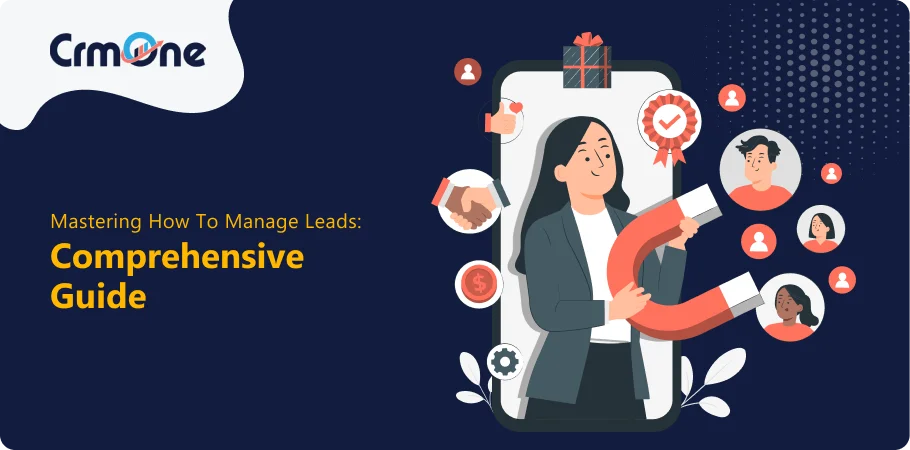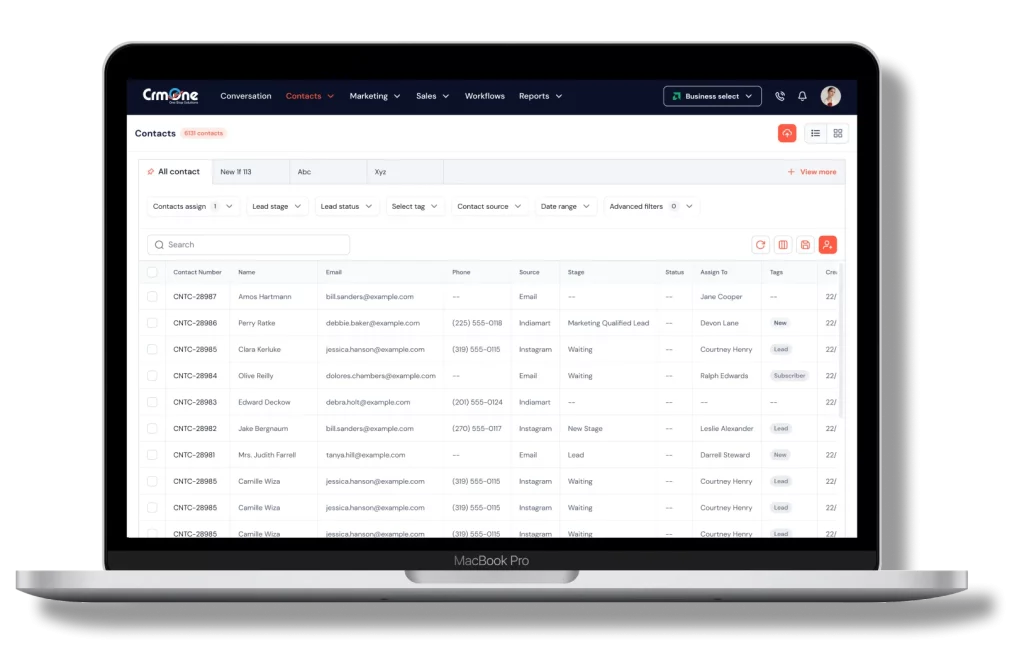In today’s fiercely competitive business environment, mastering the lead management process is crucial for maintaining a competitive edge. Serving as the gateway to potential sales opportunities, effective lead management isn’t merely a tactic but an essential requirement for sustainable growth. In this comprehensive guide, we’ll delve into the intricacies of the lead management process, untraveling strategies, best practices, and actionable insights to empower your sales team and foster tangible results.
Whether you’re a seasoned sales leader or just starting out, this guide will equip you with the knowledge to transform your lead management from disjointed efforts to a well-oiled machine. We’ll explore proven techniques for attracting high-quality leads, meticulously qualifying them, and nurturing them into loyal customers. Get ready to witness a surge in qualified leads, accelerated sales cycles, and a significant boost to your bottom line.
The Importance of Lead Management process
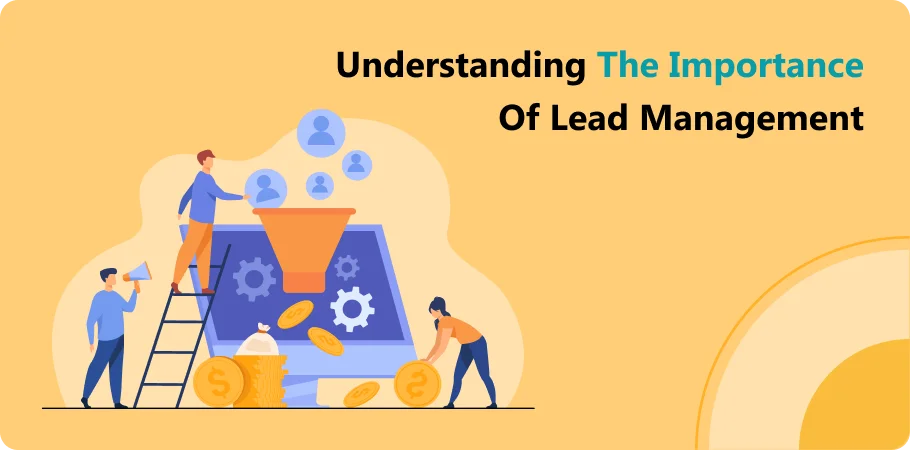
In today’s dynamic business landscape, understanding the importance of the lead management process is paramount. As the foundation for nurturing customer relationships and driving conversions, effective lead management best practices are indispensable. In this exploration, we’ll delve into the essence of customer relationship management, emphasizing the role of lead management best practices in optimizing sales outcomes. At the heart of any successful sales endeavor lies a robust lead management process. It serves as the backbone of lead management.
This well-defined process ensures a steady stream of qualified leads are nurtured and guided through the sales funnel. By implementing best practices, businesses can refine lead qualification, personalize communication, and ultimately convert a higher percentage of leads into satisfied customers. This translates to increased sales, maximized ROI, and a sustainable competitive advantage.
Streamlining the Sales Process:
In the pursuit of heightened efficiency and performance, optimizing the sales process becomes paramount. With a focus on maximizing productivity and revenue generation, aligning the sales team efforts and fine-tuning the sales pipeline become imperative.
In this endeavor, it’s essential to leverage strategies and tools to empower the sales team, while ensuring a seamless flow through the sales pipeline to capitalize on opportunities effectively.
Identifying Qualified Leads:
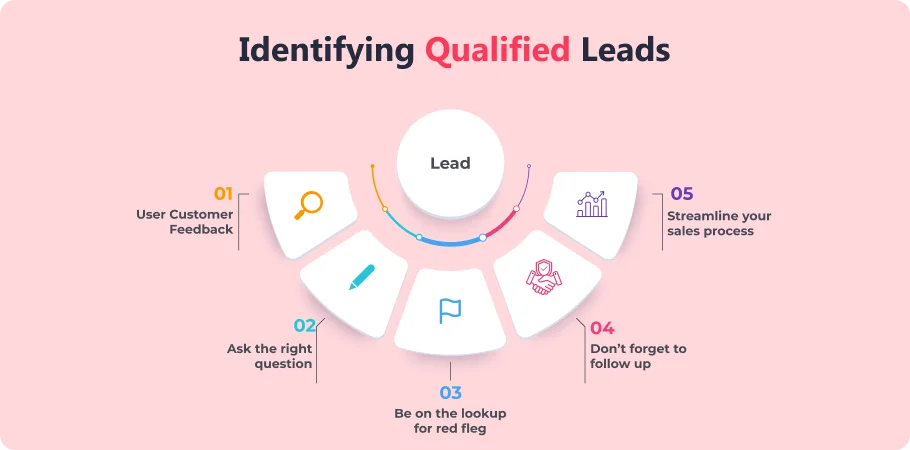
In the pursuit of identifying qualified leads, a robust lead management system plays a pivotal role. By leveraging advanced lead management system, businesses can efficiently sift through and prioritize leads according to predefined criteria, ensuring attention is directed towards the most promising opportunities.
It’s imperative not only to identify but also to nurture leads through strategic engagement and personalized interactions, cultivating meaningful relationships that drive conversions and foster long-term loyalty.
Enhancing Customer Relationships:
In the realm of enhancing customer relationships, integrating lead management software emerges as a vital strategy. This software empowers businesses to effectively track and analyze interactions with potential customers, fostering a deeper understanding of their needs and preferences.
By leveraging the capabilities of lead management software, organizations can tailor their approach, delivering personalized solutions and experiences that resonate with potential customers. This not only strengthens the connection between the business and its audience but also cultivates trust and loyalty, establishing a solid groundwork for long-term success.
Improving Conversion Rates:
In the quest to improve conversion amount, strategically engaging the target audience is essential. By optimizing the entire lead management process, companies can efficiently cultivate leads and lead them through the process. sales funnel towards conversion. This involves comprehending the requirements and desires of the intended audience. and tailoring marketing efforts and sales tactics accordingly.
Through a comprehensive approach to lead management, organizations can boost involvement, foster confidence, and ultimately raise. conversion rates, driving sustainable growth and success.
Book a CrmOne Demo
Experience the CrmOne simplicity and power. Our experts will show you the best ways to use it and answer your questions in real time. See how CRMOne fits your needs.
The Lead Management Process: A Step-by-Step Approach
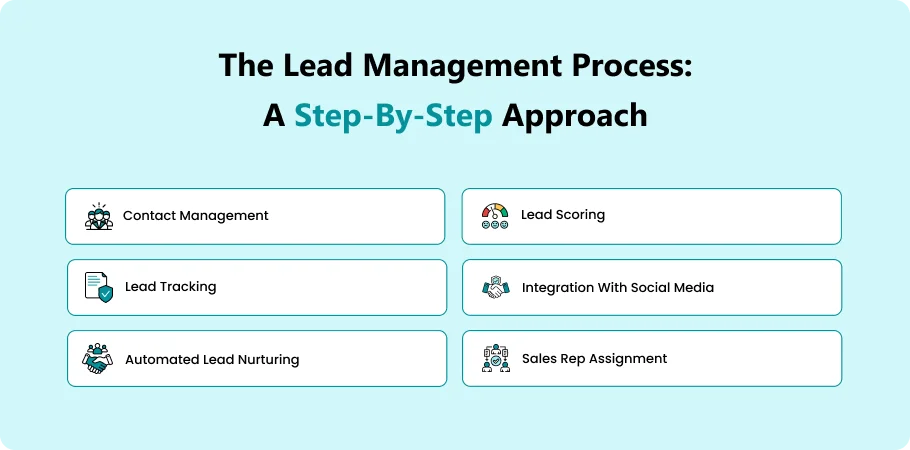
A systematic lead management process comprises several crucial steps:
Lead Capture:
In the domain of lead capture, securing potential leads is paramount. By effectively capturing leads, businesses can acquire valuable potential opportunities and guide them through the sales journey. This involves implementing strategies and utilizing tools to acquire leads from various sources, such as websites, social media platforms, and events.
By leveraging these techniques, organizations can expand their pool of potential lead and increase their chances of conversion, driving growth and success in the competitive marketplace.
Lead Qualification:
In the process of lead qualification, assessing potential leads is crucial. By conducting lead qualification, businesses can determine which prospects are most likely to become quality leads and warrant further attention from the sales team. This involves evaluating factors such as demographics, engagement level, and fit with the company’s ideal customer profile.
By prioritizing quality leads, organizations can optimize their resources and focus their efforts on prospects with the highest potential for conversion, ultimately driving efficiency and improving sales outcomes.
Lead Nurturing:
In the realm of lead nurturing, fostering relationships with potential customers is paramount. By actively nurturing leads, businesses can guide them through the sales funnel, gradually building trust and engagement. This process involves nurturing leads by providing valuable content, personalized communication, and timely follow-ups to address their needs and concerns.
As leads progress and demonstrate readiness, they transition into sales-ready leads, indicating a higher likelihood of conversion. By prioritizing lead nurturing efforts, organizations can enhance the quality of their leads and increase the likelihood of closing deals, driving sustainable growth and success.
Lead Scoring:
In the realm of lead scoring, evaluating potential prospects is key. By assigning lead scores, businesses can effectively assess the likelihood of conversion and prioritize their efforts accordingly. This process involves analyzing various factors such as engagement level, demographics, and behavior to determine the quality and readiness of leads.
With lead scores in place, the marketing team can effectively distribute resources and concentrate on leads showing the greatest promise. for conversion. This strategic approach ensures that efforts are directed towards prospects most likely to result in sales, maximizing the marketing team’s impact and driving overall success.
Lead Distribution:
In the realm of lead distribution, managing leads from various sources is essential. By effectively organizing lead sources, businesses can ensure a streamlined pipeline management process. This involves categorizing leads based on their origin, such as website inquiries, social media interactions, or event registrations, and allocating them to the appropriate sales representatives or teams.
Through efficient pipeline management, businesses can prioritize leads based on their source and stage in the sales cycle, optimizing resource allocation and increasing the likelihood of conversion. This strategic approach to leads distribution facilitates smoother pipeline administration, enhancing overall efficiency and driving sales growth.
Sales Follow-Up:
In the realm of sales follow-up, engaging with customers throughout their journey is paramount. Sales reps play a pivotal role in this process, reaching out to prospects at key touchpoints to provide support and guidance. By understanding the customer journey, sales reps can tailor their follow-up approach accordingly, addressing specific needs and concerns at each stage.
This proactive engagement not only strengthens the relationship between sales reps and customers but also ensures a personalized experience that enhances satisfaction and loyalty. Through consistent and timely follow-up, sales reps can foster leads effectively, guiding them towards conversion and fostering long-term relationships that drive business growth.
Data Analysis:
In the realm of data analysis, automating lead assignment is essential for efficient operations. By leveraging advanced algorithms, businesses can automatically assign directs leads to the most appropriate sales representatives, depending on predefined criteria. This not only streamlines the lead management process but also ensures that each lead receives prompt attention, maximizing the chances of conversion.
Additionally, utilizing the best lead management tools empowers organizations to extract comprehensive insights from data, facilitating informed decision-making and strategic planning. Through effective data analysis, businesses can optimize their operations, enhance performance, and maintain a competitive edge in today’s dynamic marketplace.
Implementing an Effective Lead Management Strategy:
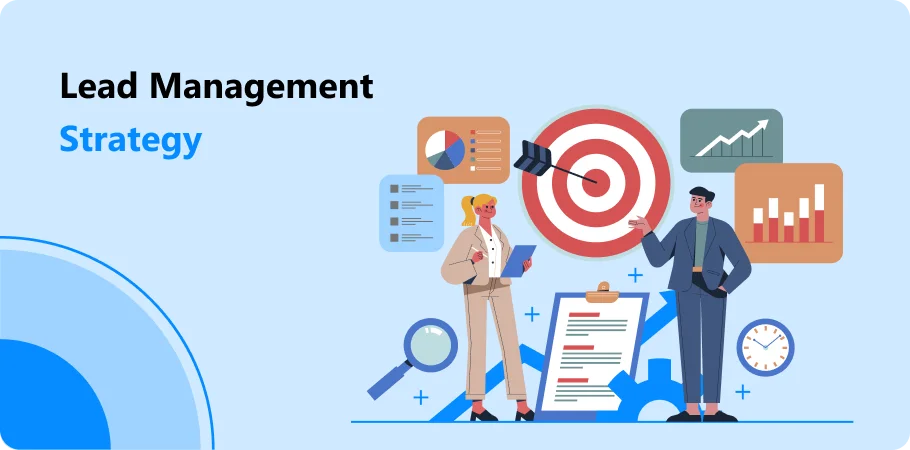
To elevate lead management efforts, consider the following strategies:
Align Sales and Marketing Teams:
In the pursuit of synergy between sales and marketing, aligning efforts is paramount. Through promoting transparent communication and mutual objectives, businesses can ensure that both teams work seamlessly towards common objectives. This entails not only equipping sales reps with the necessary tools and resources but also establishing effective sales lead management strategies that prioritize collaboration between departments.
By aligning sales rep and marketing efforts, organizations can streamline processes, improve efficiency, and enhance overall performance, ultimately driving success in today’s competitive landscape.
Leverage Technology:
In today’s fast-paced business landscape, harnessing technology is essential to effectively manage operations and ensure all team members are on the same page. By capitalizing on innovative tools and platforms, businesses can streamline processes, enhance collaboration, and drive efficiency. This involves implementing robust systems that facilitate seamless communication and information sharing across departments.
By keeping up-to-date with technological advancements and utilizing them strategically, organizations can optimize workflows, improve productivity, and achieve greater success in an ever-evolving marketplace.
Define Lead Criteria:
Defining lead criteria is crucial in identifying prospective customers and determining their status as qualified lead. These criteria serve as benchmarks for evaluating the suitability and readiness of leads for further engagement.
By clearly outlining parameters such as demographics, behavior, and level of interest, businesses can effectively allocate their efforts strategically and concentrate on leads demonstrating the greatest potential. for conversion. This strategic method guarantees the allocation of resources efficiently, maximizing the likelihood of successfully nurturing qualified lead through the sales funnel.
Implement Lead Scoring:
Implementing lead scoring is integral to the lead generation process, enabling businesses to systematically assess the value and potential of leads collected. By assigning scores based on predetermined criteria such as demographics, engagement level, and behavioral indicators, organizations can prioritize their lead collection efforts and focus on prospects most likely to convert.
This strategic approach not only streamlines lead generation but also enhances the efficiency of the sales process, as sales teams can prioritize their efforts and allocate resources effectively to pursue leads with the greatest potential for success.
Provide Ongoing Training:
Providing ongoing training is essential to equip teams with the necessary skills and knowledge to effectively support marketing and sales efforts. By ensuring that team members are well-versed in identifying and nurturing sales qualified lead, companies can improve the planning and effectiveness of their marketing and sales endeavors initiatives.
Ongoing training programs allow teams to stay updated on industry trends, best practices, and new techniques, empowering them to adapt to evolving market dynamics and seize opportunities for growth. This commitment to continuous learning not only strengthens team capabilities but also cultivates a culture of excellence and innovation within the organization.
Best Practices for Effective Lead Management process
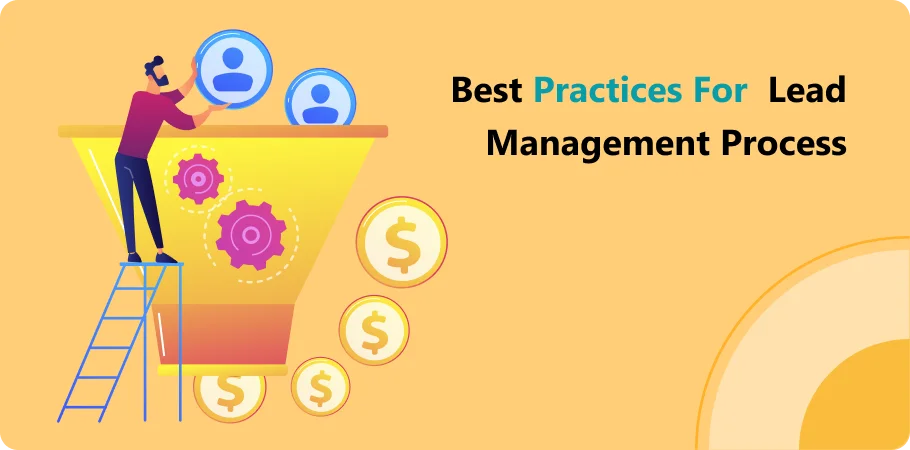
To optimize lead management efforts, adhere to these best practices:
Regularly Review Lead Data:
Regularly reviewing lead data is essential for optimizing sales and marketing strategies, leveraging the capabilities of CRM software. By analyzing data insights provided by CRM software, companies can gain valuable insights into lead behavior, preferences, and engagement patterns.
This enables them to make informed decisions, refine targeting strategies, and tailor their approach to effectively foster leads through the sales funnel. By staying proactive in reviewing lead data, organizations can identify trends, spot opportunities, and continuously improve their lead management processes to drive sustainable growth and success.
Segment Leads:
Segmenting leads based on lead information is crucial for personalized targeting and effective lead management. By categorizing leads into distinct groups according to demographics, behavior, or interests, businesses can tailor their marketing messages and sales efforts to better resonate with each segment. This approach allows for more precise and proper communication, thereby increasing the probability of engagement and conversion.
Additionally, segmenting leads enables businesses to prioritize their efforts, focusing resources on high-potential segments and maximizing the return on investment. Overall, segmentation empowers businesses to optimize their lead management strategies and drive better results.
Foster Relationships:
Fostering relationships is essential in the process of lead nurturing, especially after collect leads. By establishing meaningful connections with prospects, businesses can build trust and credibility over time. This involves engaging leads through personalized communication, providing valuable content, and addressing their specific needs and concerns.
By consistently nurturing these relationships, businesses can strengthen their brand affinity and increase the likelihood of conversion. Ultimately, fostering relationships is key to cultivating long-term customer loyalty and driving sustainable business growth.
Monitor Performance Metrics:
Monitoring performance metrics is integral to implementing lead management best practices effectively. By consistently examining essential metrics like conversion rates, lead quality, and engagement levels, businesses can acquire insights into the efficacy of their lead management strategies.
This allows them to identify areas for improvement, hone their approach, and optimize the impact of their efforts. By staying proactive in monitoring performance metrics, businesses can ensure that they are consistently optimizing their lead management processes and driving sustainable growth.
Continuously Improve:
The pursuit of continuously improving is essential for businesses aiming to generate more leads. By consistently evaluating and refining lead generation strategies, businesses can adjust to evolving market dynamics and customer preferences.
This involves analyzing the performance of lead generation campaigns, identifying areas for enhancement, and implementing iterative improvements. Through nurturing a culture of perpetual enhancement, businesses can maximize their lead generation efforts, attract a greater volume of leads, and ultimately drive sustained business growth.
Conclusion
In conclusion, mastering lead management is imperative for driving sales success and fostering enduring customer relationships. By implementing a strategic lead management process, leveraging technology, and embracing best practices, companies can unleash their complete potential and attain continual growth in today’s dynamic market landscape.
Remember, effective lead management isn’t just about acquiring leads; it’s about nurturing relationships and guiding prospects towards conversion. With appropriate strategies implemented, your organization can flourish amidst competition and emerge as a leader in your industry.
Get started for Free
Start for free today. Boost your sales by clicking the Get Started button. With CRMOne, you can manage leads, sales, and customer service all in one place.
